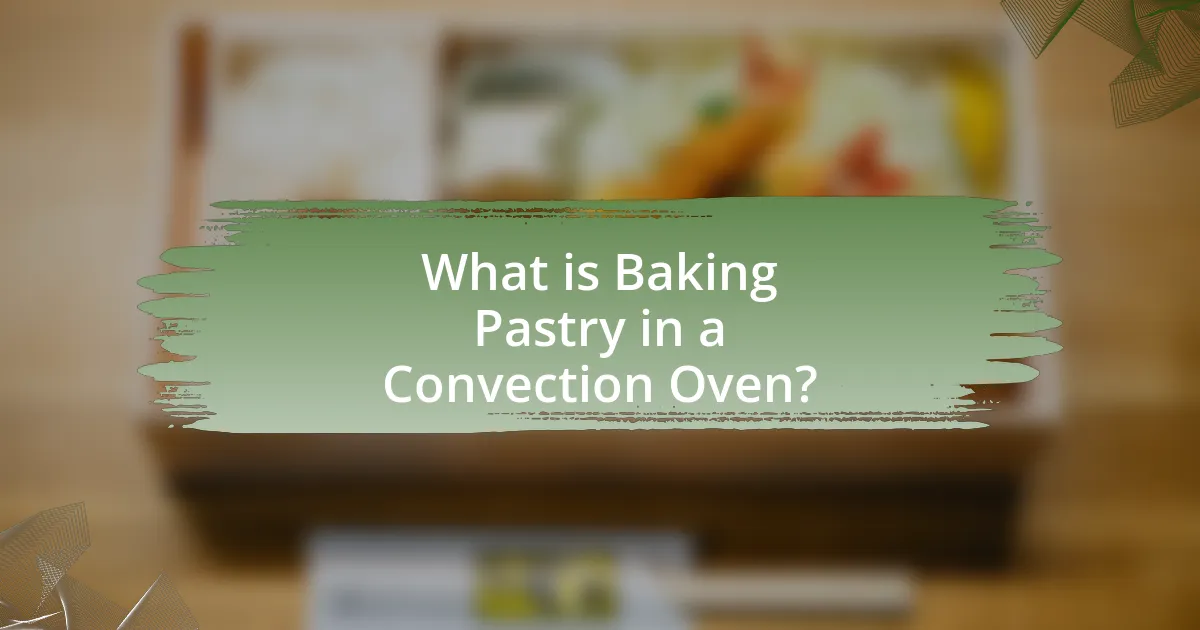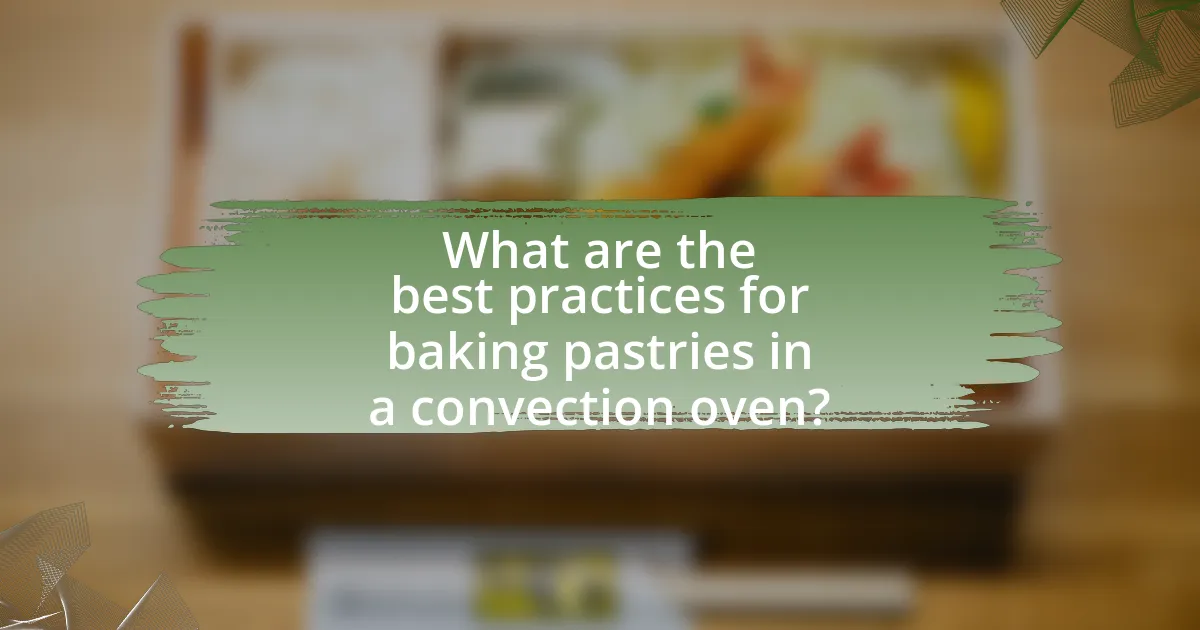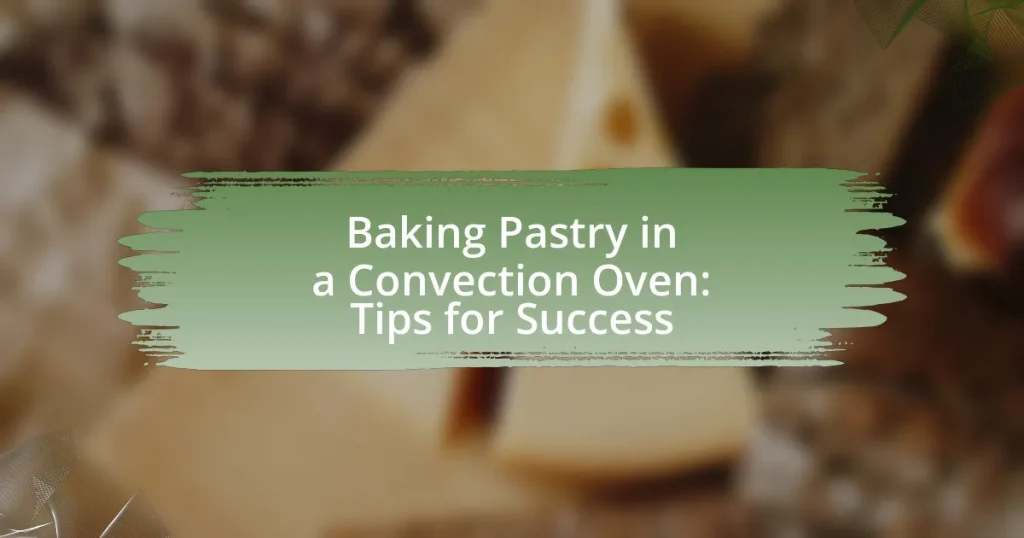Baking pastry in a convection oven utilizes a method that circulates hot air, resulting in even cooking and enhanced texture, making pastries flakier and crispier. This article outlines the differences between convection and conventional ovens, highlighting key features such as adjustable fan speed and precise temperature control that impact pastry baking. It discusses the types of pastries that benefit most from convection baking, the advantages of using this method, and best practices for achieving optimal results. Additionally, it covers temperature adjustments, common mistakes to avoid, and tools that can improve baking outcomes in a convection oven.

What is Baking Pastry in a Convection Oven?
Baking pastry in a convection oven involves using a cooking method that circulates hot air around the food, resulting in even cooking and browning. This technique enhances the texture of pastries, making them flakier and crispier compared to traditional baking methods. Convection ovens typically operate at lower temperatures and require shorter cooking times, which can improve the overall quality of baked goods.
How does a convection oven differ from a conventional oven for baking pastries?
A convection oven differs from a conventional oven for baking pastries primarily by utilizing a fan to circulate hot air, which promotes even cooking and browning. This air circulation allows pastries to bake more quickly and evenly, often resulting in a flakier texture and better rise due to reduced moisture in the oven environment. Studies indicate that convection ovens can reduce baking times by approximately 25% compared to conventional ovens, making them more efficient for pastry preparation.
What are the key features of a convection oven that impact pastry baking?
The key features of a convection oven that impact pastry baking include even heat distribution, adjustable fan speed, and precise temperature control. Even heat distribution is achieved through a fan that circulates hot air, ensuring that pastries bake uniformly, which is crucial for achieving the desired texture and rise. Adjustable fan speed allows bakers to customize airflow based on the type of pastry, enhancing browning and crispiness. Precise temperature control is vital, as it enables bakers to maintain consistent baking conditions, which is essential for delicate pastries that require specific temperatures to rise properly. These features collectively contribute to improved baking results, making convection ovens particularly effective for pastry preparation.
How does air circulation in a convection oven affect baking times?
Air circulation in a convection oven reduces baking times by promoting even heat distribution. The fan in a convection oven circulates hot air around the food, which allows for faster cooking and browning compared to traditional ovens. Research indicates that convection ovens can reduce baking times by approximately 25% and may allow for lower cooking temperatures, typically by 25 degrees Fahrenheit, without compromising the quality of the baked goods. This efficiency is due to the consistent airflow that eliminates hot and cold spots, ensuring that all parts of the food are exposed to uniform heat.
What types of pastries can be baked in a convection oven?
A convection oven can bake a variety of pastries, including puff pastry, croissants, tarts, and cookies. The circulating hot air in a convection oven promotes even baking and browning, making it ideal for these types of pastries. For instance, puff pastry benefits from the consistent temperature, allowing it to rise properly and achieve a flaky texture. Similarly, croissants require even heat for optimal layering and crispness. Tarts and cookies also achieve better results in terms of texture and color when baked in a convection oven due to the efficient heat distribution.
Which pastries benefit most from convection baking?
Pastries that benefit most from convection baking include puff pastry, croissants, and meringues. Convection baking circulates hot air, which promotes even browning and crispiness, essential for these flaky and airy pastries. For instance, puff pastry relies on steam to create layers, and the consistent heat from convection helps achieve the desired rise and texture. Similarly, croissants benefit from the rapid heat circulation, resulting in a golden, flaky crust. Meringues also achieve a better texture and drying time due to the efficient air movement in convection ovens.
Are there specific pastry recipes that work best in a convection oven?
Certain pastry recipes, such as puff pastry, meringues, and cookies, work exceptionally well in a convection oven. The convection oven’s fan circulates hot air, promoting even baking and browning, which is crucial for achieving the flaky layers in puff pastry and the crisp texture in meringues. Additionally, cookies benefit from the consistent temperature and airflow, resulting in a uniform bake and enhanced spread. Studies indicate that convection ovens can reduce baking time by about 25%, making them ideal for these types of pastries.
What are the advantages of using a convection oven for baking pastries?
Using a convection oven for baking pastries offers several advantages, primarily due to its efficient heat distribution. Convection ovens utilize a fan to circulate hot air, resulting in even cooking and browning, which is essential for achieving the perfect pastry texture. This method can reduce baking time by approximately 25% compared to traditional ovens, allowing for quicker preparation. Additionally, the consistent temperature helps pastries rise uniformly, enhancing their flakiness and overall quality. Studies indicate that convection baking can lead to superior results in pastry production, making it a preferred choice among professional bakers.
How does a convection oven improve the texture of baked pastries?
A convection oven improves the texture of baked pastries by circulating hot air around the food, which promotes even cooking and browning. This consistent airflow helps to create a crispier exterior while maintaining a tender interior, resulting in a more desirable texture. Studies have shown that the convection process can reduce baking time by up to 25%, allowing pastries to rise properly and develop a flaky structure. The enhanced heat distribution also minimizes the risk of sogginess, ensuring that pastries achieve the ideal balance of crunch and softness.
What energy efficiency benefits does a convection oven provide?
A convection oven provides significant energy efficiency benefits by utilizing a fan to circulate hot air, which allows for faster cooking times and lower energy consumption. This method of heat distribution ensures that food cooks evenly and often at lower temperatures compared to conventional ovens, typically reducing cooking times by 25% to 30%. Consequently, this efficiency translates to less energy usage, as the oven does not need to operate as long to achieve the desired cooking results.
How can you adjust baking techniques for a convection oven?
To adjust baking techniques for a convection oven, reduce the baking temperature by 25°F (about 14°C) compared to conventional oven settings. This adjustment is necessary because convection ovens circulate hot air, which cooks food more evenly and efficiently, leading to faster cooking times. Additionally, monitor baking times closely, as items may bake 10-15% faster in a convection oven. This is supported by the fact that the consistent airflow in convection ovens promotes even heat distribution, which can significantly impact the final texture and doneness of baked goods.
What common mistakes should be avoided when baking pastries in a convection oven?
Common mistakes to avoid when baking pastries in a convection oven include not adjusting the temperature and time, overcrowding the oven, and failing to use proper baking sheets. Not adjusting the temperature is critical because convection ovens circulate hot air, often requiring a temperature reduction of 25°F compared to conventional ovens. Overcrowding can impede airflow, leading to uneven baking, while using inappropriate baking sheets can affect heat distribution. These factors can significantly impact the final texture and doneness of the pastries.

What are the best practices for baking pastries in a convection oven?
The best practices for baking pastries in a convection oven include reducing the baking temperature by 25°F compared to conventional ovens, ensuring even air circulation by spacing pastries adequately, and monitoring baking time closely as convection ovens typically cook faster. These practices enhance browning and flakiness, which are crucial for pastry quality. Research indicates that convection ovens can improve heat distribution, leading to more consistent results in pastry baking.
How should you prepare your pastry dough for convection baking?
To prepare your pastry dough for convection baking, chill the dough thoroughly before baking. Chilling solidifies the fats, which helps maintain the structure and flakiness during the convection process. Additionally, roll the dough to an even thickness to ensure uniform cooking, as convection ovens circulate hot air, promoting even browning. It is also advisable to dock the dough with a fork to prevent bubbling and ensure a flat surface. These steps enhance the final texture and appearance of the pastry, aligning with the convection oven’s cooking method that relies on consistent airflow for optimal results.
What ingredients are crucial for achieving the best results in a convection oven?
To achieve the best results in a convection oven, using ingredients that promote even cooking and browning is crucial. Key ingredients include high-quality flour, which provides structure; fats like butter or oil, which enhance moisture and flavor; and eggs, which contribute to leavening and richness. The use of these ingredients ensures that baked goods rise properly and develop a desirable texture, as convection ovens circulate hot air, allowing for more efficient cooking and browning.
How does the thickness of the pastry affect baking time in a convection oven?
The thickness of the pastry directly affects the baking time in a convection oven, with thicker pastries requiring longer baking times. This is due to the fact that thicker layers of pastry take more time for heat to penetrate and cook the interior thoroughly. For example, a standard pastry thickness of about 1/8 inch typically bakes in 15-20 minutes, while a thicker pastry of 1/2 inch may take 25-30 minutes or more. The convection oven’s fan circulates hot air, which can help cook the outer layers faster, but the core of thicker pastries still needs additional time to reach the desired doneness.
What temperature adjustments should be made when using a convection oven?
When using a convection oven, it is recommended to reduce the temperature by 25°F (approximately 14°C) compared to conventional oven settings. This adjustment is necessary because convection ovens circulate hot air, which cooks food more evenly and efficiently, leading to faster cooking times. The reduction in temperature helps prevent overcooking and ensures that baked goods, such as pastries, achieve the desired texture and doneness without burning.
How much should you reduce the temperature compared to conventional baking?
Reduce the temperature by 25 to 30 degrees Fahrenheit compared to conventional baking. This adjustment is necessary because convection ovens circulate hot air, which cooks food more evenly and efficiently, leading to faster cooking times. Studies indicate that this temperature reduction helps prevent over-browning and ensures that pastries rise properly without becoming dry.
What role does preheating play in successful convection baking?
Preheating is essential in successful convection baking as it ensures that the oven reaches the desired temperature before food is placed inside. This process allows for even heat distribution, which is crucial in convection baking where a fan circulates hot air to cook food uniformly. When the oven is preheated, it helps achieve the optimal rise and browning of baked goods, as they begin cooking immediately upon entering the oven. Studies indicate that preheating can improve baking results by reducing cooking time and enhancing texture, leading to a more consistent final product.
What tips can enhance your pastry baking experience in a convection oven?
To enhance your pastry baking experience in a convection oven, preheat the oven to the correct temperature and reduce the baking time by about 25%. Convection ovens circulate hot air, which can lead to faster cooking and browning. Additionally, use light-colored baking sheets to prevent over-browning and ensure even heat distribution. Placing pastries on the middle rack allows for optimal air circulation, promoting even baking. Finally, monitor the pastries closely towards the end of the baking time, as they may finish sooner than in a conventional oven.
How can you ensure even baking and browning of pastries?
To ensure even baking and browning of pastries, use a convection oven set to the appropriate temperature and rotate the baking trays halfway through the cooking process. Convection ovens circulate hot air, which promotes uniform heat distribution, leading to consistent baking results. Additionally, placing pastries on the center rack allows for optimal airflow around them, further enhancing evenness in baking and browning. Studies show that convection baking can reduce cooking time by up to 25% while improving browning due to the efficient heat transfer.
What tools or accessories can improve your convection baking results?
Using a baking stone can significantly improve your convection baking results by providing even heat distribution and enhancing crust quality. Baking stones absorb moisture and help create a crispier crust, which is particularly beneficial for bread and pizza. Additionally, using a convection-safe baking sheet or pan, preferably made of aluminum or stainless steel, can enhance airflow around the food, promoting even cooking and browning. Silicone baking mats can also be advantageous as they prevent sticking and facilitate easy cleanup while ensuring consistent heat transfer. These tools and accessories are widely recommended by culinary experts for optimizing convection baking performance.




